
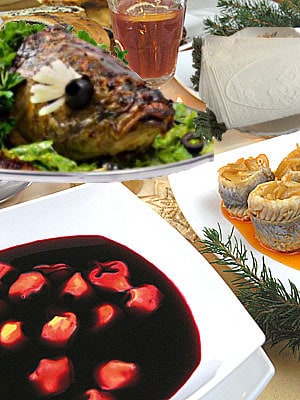
Since the beginning of recorded history, food and drink has always been synonymous with festive occasions. Be it the conquering of an opponent’s village, the birth of a new child, or the marriage of the oldest daughter (hurray), traditional ethnic foods and spirits usually accompany the celebration of each occasion. For some occasions, the quantity of food is the overriding factor, while for others, like the Polish celebration of the birth of our Lord, quality is the main objective.
The traditional Polish Christmas Eve supper is a meatless occasion. However, Slavic ingenuity has more than compensated for the absence of meat dishes, and even the most discriminating palate is satisfied with offerings from the other major food groups. Listed below are examples of dishes served by my mother for Christmas Eve supper. Although the dishes are simple, each is steeped in tradition, meaning, and fond memories. Oh, yes, an extra plate was always set for the unexpected visitor, be it a guest or a pilgrim.
First dish – Fried mushrooms.
Dried mushrooms are soaked in warm water or boiled for a short period, then breaded and fried on a pan covered with a thin layer of vegetable oil.
Second dish – cooked vegetable salad.
Slightly undercooked vegetables (carrots, celery root, one parsley root or parsnip, one or two potatoes ) are cut in 1/4″ cubes. Also raw green celery, leeks, onion, a couple of hard boiled eggs, Polish pickle, and a small sour apple, are cubed. Put all the above into a large stainless or plastic bowl and mix it with a can of green peas or well cooked red beans. Sometimes a herring is chopped and mixed in. The dressing is made from sour cream or yogurt, yellow or coarse German prepared mustard, some red wine, salt, pepper, maybe a pinch of Vegeta. Everything is stirred gently with dressing and served in a ceramic bowl, covered to prevent surface drying.
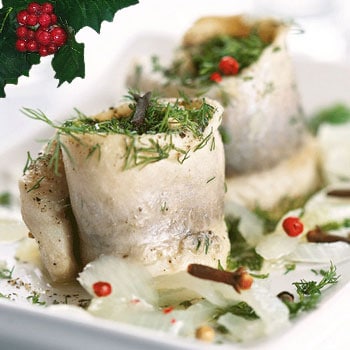
Third dish – rolmopsy.
Herring fillets (matjess are the best) are cut into strips. Five or six grains of mustard seeds are tightly wrapped together with a slice of Polish pickle and carrot in the herring pieces. The rolmopsy are now layered with some onion in a glass jar and marinated in white vinegar half-and-half with water. Addition of a bay leaf or two, allspice , salt and pepper, completes the dish. Leftovers can be refrigerated and should be consumed within 10 days.
Fourth dish – Sauerkraut with peas
Drain, rinse if very sour and chop coarsely 1 pt or more sauerkraut, transfer to pot, add cold water to cover, 1 bayleaf and 1 mushroom bouillon cube and bring to boil. Reduce heat and cook 30 min uncovered, adding more water as it evaporates. Add 1/2 t caraway seeds, cover and cook another 30 min or until tender. While it cooks, fry up 3-4 oz washed and diced portobello mushrooms and 1 chopped onion in 2-3 T butter until lightly browned and add to sauerkraut along with 1 c drained, canned chickpeas and 1 t sugar. Simmer another 30 min or longer. Season with pepper and marjoram to
Fifth dish – fried fish.
Traditionally, we should serve carp, but my mom substituted cod or other Atlantic fish, sauteed on medium-hot oil. Pieces of fish or fillets are covered with flour (just like „shake n’ bake” in a plastic bag), then fried in hot oil (320 deg.F). The fish is salted after removed from the pan.
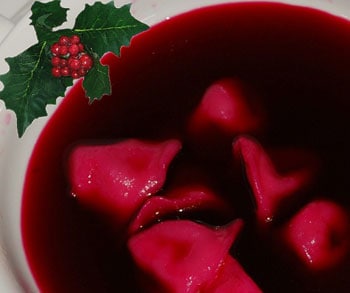
Sixth dish – clear borscht with dumplings.
Beets are very slowly boiled in water until soft, then removed from the liquid. The liquid is spiced with pepper, bay leaves, allspice, a little basil, minced garlic, Vegeta and juice from two or three lemons per half a gallon of the soup.
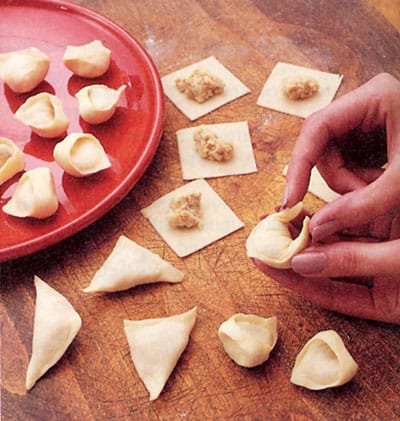
The dumplings, called „ears” for their characteristic shape, are made by wrapping a mixture prepared from chopped mushrooms fried with onion, in square pieces of Chinese dough, purchased in any grocery store (frozen section). The borscht is served hot, in large English tea cups or ordinary mugs with four or five dumplings in each one of them.
Seventh dish – krokiety.
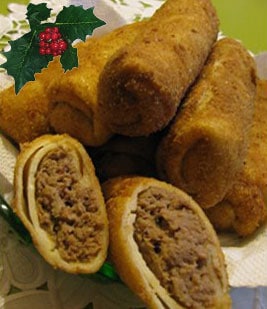
These are crepes filled with cooked broken barley (kasza), mushrooms fried with onion, some garlic, salt and pepper. The crepes are placed in a baking pan, spread with beaten egg and baked at 275 deg. F for a few minutes.
Eighth dish – red beets
This is usually a condiment, but it is so delicious that I like it simply with bread and butter. The beets, removed from the borscht, are shredded or sliced, salted, peppered and mixed with noncreamed horseradish in any proportion. Some Vegeta, lemon juice and several drops of oil will complete this original spread.
Ninth dish – pierogi
Pierogi made with cheese, cabbage and mushrooms or various fruits are so inexpensive to purchase that I recommend you simply buy them at the Polish Delis.
Tenth dish – stuffed eggs.
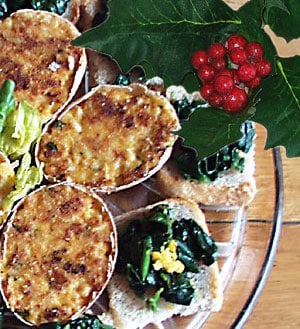
Whole hard-boiled eggs are cut in half. Egg whites and yolks are carefully spooned out, mashed with fork and then mixed with fine chopped dill, chives, parsley, onion, salt and pepper to taste, two spoons of sour cream or yogurt and one raw egg per ten eggs. The filling now goes back into the egg shells. Sprinkle the top with bread crumbs. Fry them upside down in oil at medium-high temperature.
Eleventh dish – hard-boiled eggs with mustard dressing.
Egg halves are placed on a flat plate and covered with sauce made by mixing sour cream (or yogurt) with prepared mustard, dill, salt, pepper, some wine and a drop or two of honey. Do not go overboard with the last ingredient.
Twelfth dish – herring in oil.
Pieces of herring (1-inch squares), are layered in a jar with coarsely chopped onion (lots of onion) – some allspice is added along with a bay leaf – and marinated in canola oil overnight. To serve, place the pieces on an oval plate, cover them with oil from the jar, and sprinkle with onion and ground pepper.
After the presents are unwrapped, sweets such as fruitcakes, yeast raised loaves, poppy strudels, nut cakes and sometimes babas, similar to the Easter ones are served. Dried fruit compote adds specific aroma to the Polish Christmas atmosphere. Moderate amounts of homemade wine, and cognac with coffee were also enjoyed.
We wish you a Happy Holidays and a Prosperous New Year!
Almond Soup
– also a traditional dish on Christmas Eve
(Zupa Migdalowa)
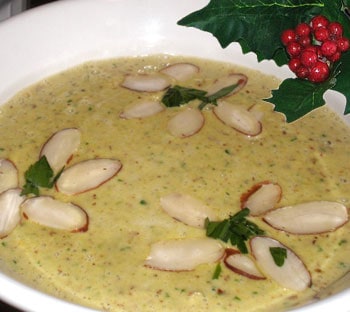
5 cups milk
1/2 pound blanched almonds, ground twice
5 bitter almonds (optional)
1 teaspoon almond extract
2 cups cooked rice
1/3 cup sugar
1/4 cup raisins or currants
1. Heat milk just to simmering in a large sauce pan.
2. Add all the ingredients; stir until well mixed.
Cook over low heat 3 to 5 minutes.
3. Serve hot as is traditional for Christmas, or chill before serving. Makes about 2 quarts.

